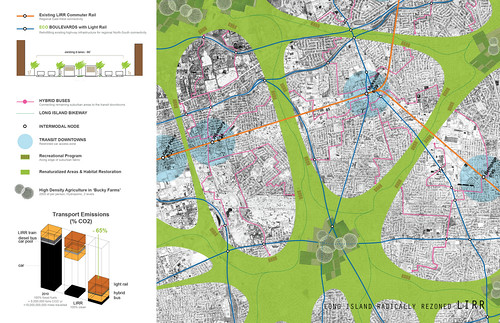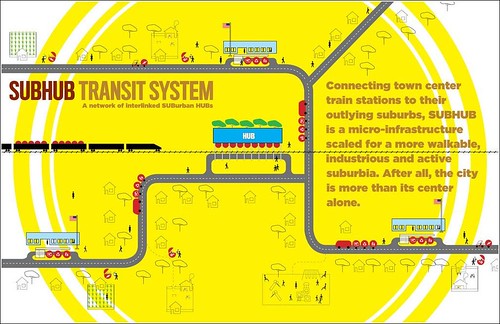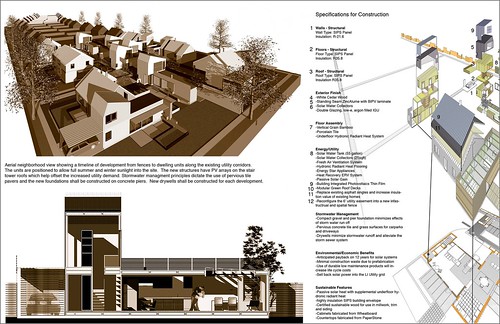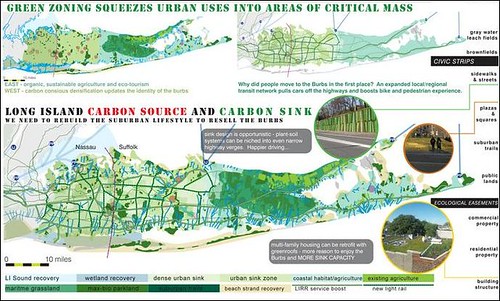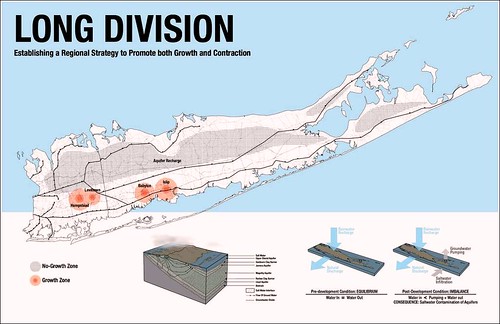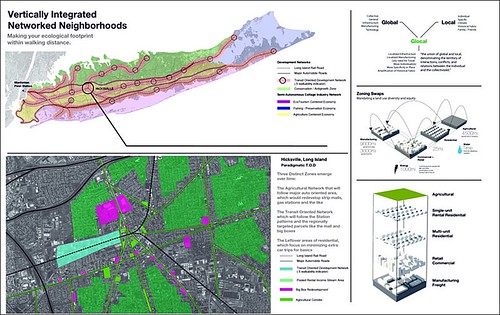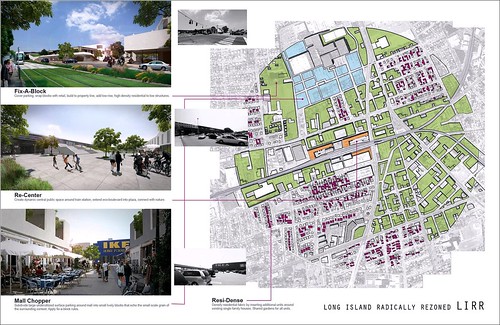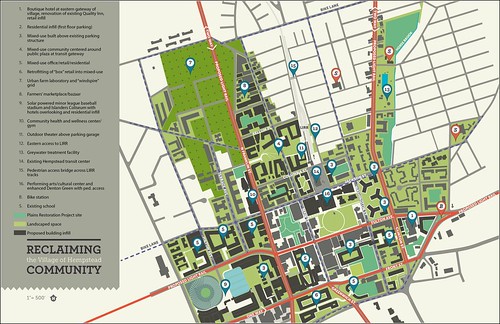Imaginative suburban retrofits among winners in 'Build a Better Burb' contest

Posted October 8, 2010 at 1:55PM
An urban planning contest based on the premise that significantly reconfigured suburbs could be more sustainable than existing ones has produced some intriguing ideas. In particular, the Long Island Index, a project of the Rauch Foundation, has just announced winners of its “Build a Better Burb” contest, which earlier this year invited architects, planners, students and others to submit bold design proposals for retrofitting vacant and underutilized lots in suburban downtowns of Long Island into “innovative and surprising new uses, forms and urbanisms”:
“Roughly equivalent to the area of Manhattan south of 50th St., 8,300 acres is a lot of land. It is still, however, only 1.1% of the land mass of Nassau and Suffolk Counties. By building in a new way on this land, rather than elsewhere on Long Island in the old way, there is tremendous opportunity to address the contemporary challenges of suburbia, by shifting focus to the prewar landscape of small towns and mass transit that languished during decades spent constructing highways, shopping malls, dream-home subdivisions and far-flung office parks. How might Long Island’s existing downtowns be creatively retrofitted – redeveloped, reinhabited and/or regreened – in ways that are economically productive, environmentally sensitive, socially sustainable, and aesthetically appealing?”
The Foundation chose 23 finalists and has this week announced five jury-selected winners, one student winner, and a “people’s choice” selected by online voting. Some of the winning entries went far beyond the concept of using the vacant land and proposed major changes throughout the island. Several proposed different ways of coupling increased density in the downtowns with new agricultural districts outside. There is a great amount of information on the contest’s website, including many images and details on all the finalists, but below is a taste of the winners:
SUBHUB Transit System, submitted by DUB Studios, Michael Piper, Frank Ruchala, Natalya Kashper, Gabriel Sandoval, and Jeff Geiringer, provides for fixed-guideway but small-scale public transit linking rail stations to public schools: "SUBHUB is a micro-infrastructure scaled for a more walkable, industrious and active suburbia. The system has three parts: re-imagined transit, a HUB at existing train stations, and SUBHUBs at existing public schools . . . In addition to making transit stops and public space at school sites in suburbia, SUBHUB provides a right-sized system for getting home grown vegetables and products to market."
Accessory Dwelling, submitted by Meri Tepper, Ted Porter, Ted Sheridan, and John Buckley, would double the density of first-generation suburbs such as Levittown through intensive use of modular accessory apartments on existing lots. As the entry states, “allowing additional dwelling on existing lots gives residents options to offer accommodation to extended family or to earn additional income through rents. Redefining traditional notions of setback, orientation, density and infrastructure allows for a community that offers more to this generation and the next.”
Building C-Burbia, submitted by Denise Hoffman Brandt, Alexa Helsell, and Bronwyn Gropp, took a decidedly ecological perspective, using vacant parcels for small-scale carbon sinks to mitigate increased density. Its graphics were densely packed with information (the image above is a small corner of one of them) and a bit more difficult to readily grasp than most, but the jist is that it would concentrate all urbanized development in the western half of the island and devote the eastern half to sustainable agriculture and eco-tourism.
AgISLAND, submitted by Amy Ford-Wagner, Tom Jost, Ebony Sterling, Philip Jonat, Emily Hull, Will Wagenlander, Meg Cederoth, Melanie George, David Greenblatt, and Melissa Targett, appealingly combined the pragmatic with the visionary:
“Symbolic as a farm town replaced by millions of square feet of office parks, massive malls, strip centers and a few isolated residential developments – Farmingdale is the poster child for Long Island sprawl development. AgISLAND replaces office parks with organic farms, fed by AgTRAIN, a conveyer connected to processing, distribution and rail to connect all of Long Island to dense centers where goods are sold . . . The office parks are relocated to our transit-oriented community, served by LIRR and light rail on Route 110. Retail, education, entertainment and residential opportunities are mixed to significantly reduce automobile reliance.”
Long Division, submitted by Kazys Varnelis, William Prince, Leigha Dennis, Kyle Hovenkotter, Momo Araki, and Alexis Burson, is like C-Burbia in that it would concentrate development on the western half of Long Island, nearest New York City. It would prohibit growth in “the east and north where the aquifer is deepest and closest to the surface. As the population of that area ages, communities such as Riverhead revert to dense villages surrounded by sustainable farming, nature preserves and other uses compatible with aquifer preservation while serving as an amenity for the vacation region of the Hamptons and for the dense west.”
The student winner was Upcycling 2.0, submitted by Ryan H. B. Lovett, John B. Simons, and Patrick Cobb. It would incrementally convert current low-density, automobile-oriented uses into agriculture, and concentrate other uses into regional economic centers served by transit and and smaller, mixed-use “neighborhood enclaves.” Innovative financing would be key: “Through the strategic market driven acquisition and re-appropriation of property, our proposal encourages interaction and desirability via new community associations that pool and manage funds for community improvements and amenities. This in turn closes economic, environmental, and social loops, while increasing civic participation, awareness, and accountability. There would be a direct correlation between your money and your neighborhood.”
The “people’s choice” was Long Island Radically Rezoned (whose acronym riffs off that of the Long Island Railroad), submitted by Tobias Holler, Katelyn Mulry, Sven Peters, Ana Serra. I liked it:
“To obtain the area needed we capitalize on the densification potential of the downtowns. Four strategies are applied to revitalize and repopulate these vacant and lifeless areas:
- “Fix-a-block: ‘wrap’ blocks given over to surface parking with public program/ retail around existing buildings and over parking structures and add low-rise high density residential ‘carpet’ on top.
- “Re-center: create central public space at the train station, this new vibrant downtown center is an extension of the eco-boulevard and re-centers towns to give them a new identity where folded landscape of public space bridges from street level to elevated train tracks.
- “Mall Chopper: subdivide large underutilized surface parking around mall into small blocks that echo the small-scale grain of the surrounding context. Apply fix-a-block rules.
- “Resi-Dense: densify residential fabric by inserting additional units around existing single-family houses.”
I have to say that I found some of the non-winning finalists to be a bit more pragmatic and more immediately interesting, for that reason, than some of the winners. For example, Reclaiming Community, submitted by Courtney Embrey and Michael Narciso, focuses on the village of Hempstead. It would increase downtown density so that ecologically sensitive lands outside can be restored: “This proposal seeks to grow vertically instead of horizontally, maximize use of brownfield sites, establish educational programs, provide desirable affordable housing, explore new ways of transit and mobility, restore the Hempstead Plains, and provide a sustainable urban agricultural enterprise.”
Go here to see all the finalists in detail.
Move your cursor over the images for credit information.
